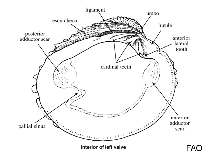Redicirce sulcata (Gray, 1838)
Google image | No image available for this species;
drawing shows typical species in Veneridae.
Classification / Names Populärnamn | synonymer | CoL | ITIS | WoRMS
Bivalvia | Venerida | Veneridae
Environment: milieu / climate zone / djupintervall / distribution range Ekologi
, usually 0 - 25 m (Ref. 53). Subtropical
Distribution Länder | FAO områden | Ekosystem | Förekomster | Utplanteringar
Indo-West Pacific.
Length at first maturity / Size / Weight / Age
Könsmognad: Lm ? range ? - ? cm
Life cycle and mating behavior Könsmognad | Reproduktion | Lek | Eggs | Fecundity | Larvae
Main reference
referenser | Koordinator | Medarbetare
Wells, F.E. 1986 Distribution of molluscs across a pneumatophore boundry in a small bay in Northwestern Australia. Journal of Molluscan Studies 52:83-90. (Ref. 77732)
IUCN Red List Status
(Ref. 130435: Version 2025-1)
CITES status (Ref. 108899)
CMS (Ref. 116361)
Threat to humans
Human uses
| FishSource |
Verktyg
Ytterligare information
Födosammansättning
Födointag
Predatorer
Max. ages / sizes
Length-weight rel.
Length-length rel.
Length-frequencies
Mass conversion
Abundans
Internet-källor
BHL | BOLD Systems | CISTI | DiscoverLife | FAO(Publication : search) | Fishipedia | GenBank (genome, nucleotide) | GloBI | Gomexsi | Google Books | Google Scholar | Google | PubMed | Tree of Life | Wikipedia (Go, sök) | Zoological Record



